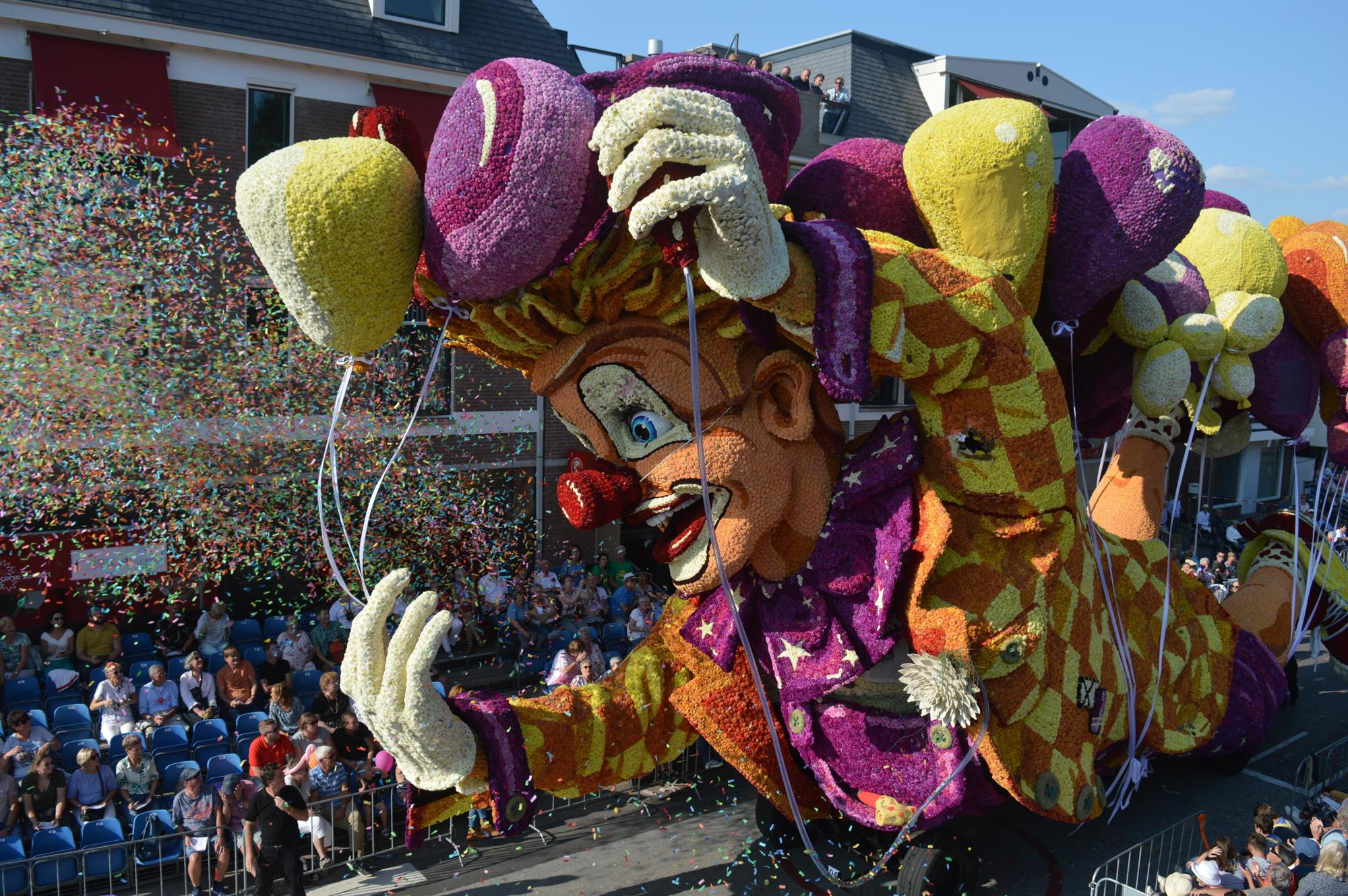Will the floats for the Zundert Flower Parade be ready on time? Things get tense during the hot summer of 2018.
“The warmest summer since 1706”, is how the Dutch Meteorological Institute, the KNMI, describes the summer of 2018 on its website. In stark contrast to previous years, things are remarkably quiet in the flower parade tents in Zundert in West Brabant. This is where the floats are constructed for the largest flower parade in the world, which is due to take place during the first weekend of September this year. In team Wernhout's tent, float designer Ronald van der Laag wipes drops of sweat off his forehead. All the work that goes into building the steel frame, pasting on the papier-mâché skin, painting the figures and (just before the parade) inserting nails into the dahlias and tapping them in place (‘prikken en tikken’) is done by volunteers. But today's turnout is low because the temperature in the tent has now risen to almost 40 degrees. Van der Laag: “We need to pull out all the stops now to get the float finished on time.”
Twenty neighbourhood teams compete against each other for the prize for the best float in the Zundert Flower Parade. Each neighbourhood team has its own unique identity and its own flag. These flags flutter in the wind in every street in Zundert during the construction period prior to the parade. This is the residents’ way of showing which neighbourhood team they support. And don’t make the mistake of thinking that next-door neighbours will always fly the same flag.
There are 19 flower parade neighbourhoods and teams in Zundert. However, ‘Schijf’, a neighbourhood that once belonged to Zundert and now belongs to Rucphen, asked to be allowed to participate again several years ago, bringing the number of teams up to 20. This just goes to show how strong the parade virus is. The young people of Zundert are infected at an early age. The children participate in their own parade - with smaller floats - two weeks after the main event. Even so, the town’s children also help construct the large floats. The volunteers who impale the millions of dahlias on nails during the last few days before the parade are mainly parents and children. Those nails are used to attach the flowers to the floats. This process of inserting nails into the flowers and tapping them in place is known as ‘prikken en tikken’.

The summer is all about the flower parade in Zundert. However, the townspeople also prepare busily for the event during the other seasons of the year. The process starts early in December, when each neighbourhood team chooses a design whose quality and feasibility has already been assessed by the flower parade management board. Many of the designers originate from Zundert. They often work in teams of two or three because they have to be present all the time in the tent during construction in order to give the volunteers instructions. Small models of these designs are presented in June during the strawberry harvest festivities.
“Allowing the neighbourhood teams to see each other’s floats before the parade used to be unthinkable”, says Ad Boemaars, who organises sponsorship and publicity on behalf of Stichting Bloemencorso Zundert, the foundation that arranges and funds the event. “In fact, the tents used to be guarded. If you were going out with a girl from a different neighbourhood, she wouldn’t be allowed into the tent.” Obviously, there is still healthy rivalry between the teams. Everybody desperately wants their float to win. “But the teams also work together closely. If one neighbourhood team has difficulty in engineering a specific movement on the float, one of the other neighbourhood teams takes a look. And if a float breaks down during the parade, everybody rushes to help.”

The parade cannot take place without dahlias. The bulbs are planted in April. Around 30,000 per neighbourhood team on average. Many neighbourhood teams also set up their parade tent at the same time. Planting the bulbs and setting up the huge tents is an annual happening for the whole neighbourhood. Once the truck chassis that serves as the platform for the float has been wheeled into the tent, scaffolds are built - up to 3 storeys high in many cases. Children under the age of twelve are not allowed to climb onto the scaffolding. They will soon be able to help at ground level - by tearing up paper for example, and pasting it onto the figure. The first time that you allowed to climb up onto the scaffolding is a special moment for many young people. The techniques used to construct flower parade floats are passed down from generation to generation. Many neighbourhood teams organise special workshops for young people - welding, for example. But new skills are also added constantly - technical skills in particular: movement and special effects are important elements of most floats. Every year, the builders eagerly accept their new challenge: what does the design look like this time? What materials are we going to use? What are the float’s moving elements and how we going to build them? In contrast to many companies and organisations that create one project group after another in order to innovate, Zundert seems to achieve this automatically. In fact, the greater the challenge for which an innovative solution needs to be found, the more the men and women building the flower parade floats like it.
On that hot summer's day in August, a couple of young girls perched high up on the scaffolding are busy welding parts together in team Wernhout's flower parade tent. Down at ground level, a father and son are pasting paper onto a wire skeleton of the clown with which they hope to wow the crowd in September. They don’t seem to have been affected by flower parade stress yet.
This lengthy build-up is all about the prize awarding ceremony, known as the ‘Zundertse jubel’. The floats drive two laps of the designated course, passing the crowded public grandstands on the market square on two occasions. The public chooses their favourite float after the first lap. Well before the parade starts, the panel of judges inspects the floats - this is known as the ‘eerste schouw’ - as they stand ready in the marshalling area. “That's the only time when you really feel the intense rivalry,” says Ad Boemaars. “At the same time, you see that the neighbourhood teams sincerely congratulate their rivals when they produce an outstanding float.” Because creating an attractive design is one thing, successfully executing it is a different matter altogether.
Once the procession has passed through the market square for the first time, the panel of judges also makes its final choice. The scores for each float are only announced when they pass the main grandstand on the market square for the second time. The winning float is singled out and asked to stop. That is when the market square explodes to the sights and sounds of the ‘Zundertse Jubel’. Ad Boemaars: “That is when the members of the winning team rush down from the grandstands, cheering at the top of their voice, the pushers come out from under the float and you see grown men burst into tears.”
During those last few days in August, the 60 million dollar question is whether team Wernhout's clown will be ready on time? Stress levels are also rocketing in the other flower parade tents. But, in the last week before ‘Parade Sunday’, the mysterious force that Ad Boemaars calls the “Power of the Parade” manifests itself again: “The people of Zundert all feel the same thing: they need me, it’s time for me to contribute, and flock to the tents to help.” ‘Prikken en tikken’ continues late into the night - and even into the small hours of the morning on the day of the parade. And then, at last, that other special moment: the float is ready, the builders remove the scaffolding, open the tent flaps and drive their magnificent creations outside. Now they can really see the results of all their hard work. The builders are proud of their achievement: ‘Just clowning around’, as their float is called, is a huge success and earns team Wernhout an official fifth place and first prize in the public vote.
The floats take part in a further procession on Monday, in front of an international audience this time. On Tuesday, their work is done and the floats are destroyed. That is also part of the tradition. Wernhout's clown has passed away. But the parade’s ability to connect and bring people together - that remains.
Bicycles decorated with dahlias: that marked the start of the world's largest flower parade in 1936. The flower parade in honour of Queen Wilhelmina's birthday was the idea of former town alderman Pieter van Ginneken. After all, the gardens of Zundert's farmers were full of dahlias. The perfect flower for farmers who had no time for their gardens: strong, easy to care for and in bloom from July to October. As the years passed, the bicycles were replaced by floats, and those floats grew larger and larger. Nowadays, each flower parade float requires about 500,000 dahlias and 20 floats participate every year. That means that 10 million dahlias are lovingly tapped into place in Zundert each year.
Each neighbourhood team has its own field where it grows dahlias of all sizes and colours. Volunteers look after the plants. They remove weeds and pick thousands of flowers. Because the more flowers you pick, the greater the number of new flowers that grow in their place. In the weeks that no dahlias are required for the parade in Zundert itself, between 15.5 and 17 million flowers are shipped out of the town to parades or other festivities in the Netherlands, Belgium and even Austria and Spain. A special flower committee manages this trading activity. The neighbourhood teams finance the construction of their floats by selling their dahlias.
Sometimes, a neighbourhood team does not have an adequate supply of flowers for its parade float. This usually occurs when the design requires a particular type of dahlia (there are about 20,000 varieties) or a particular colour. In that case, the flower committee uses its contacts to source the required flowers from elsewhere. “When a shortage is imminent, I go to Lisse and the surrounding area and asked professional growers whether we can pluck their flowers”, says Ludo Gommers, chairman of the floral committee. “Their activities focus on producing excellent bulbs, whereas we focus on the flowers. Our growing methods are unique and not used by anybody else in the Netherlands.” A shortage of flowers can also be caused by a violent hailstorm or mini tornado. Ludo: “Events like that destroy the flowers.” Things have always worked out well so far though. Flowers have either been sourced from elsewhere or there was enough time for new flowers to grow. “And if there are no other options, we use a different type of dahlia. But the colour has to be right.”

You can copy the full text of this story for free at the touch of a button